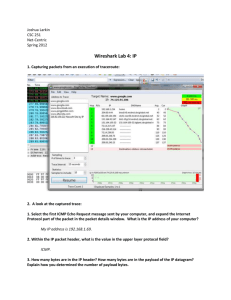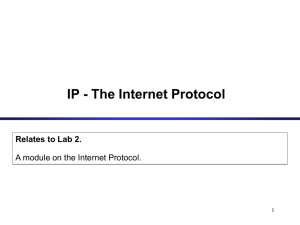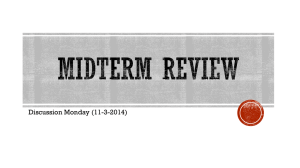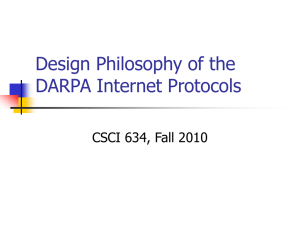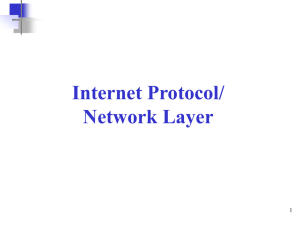IP - The Internet Protocol
advertisement
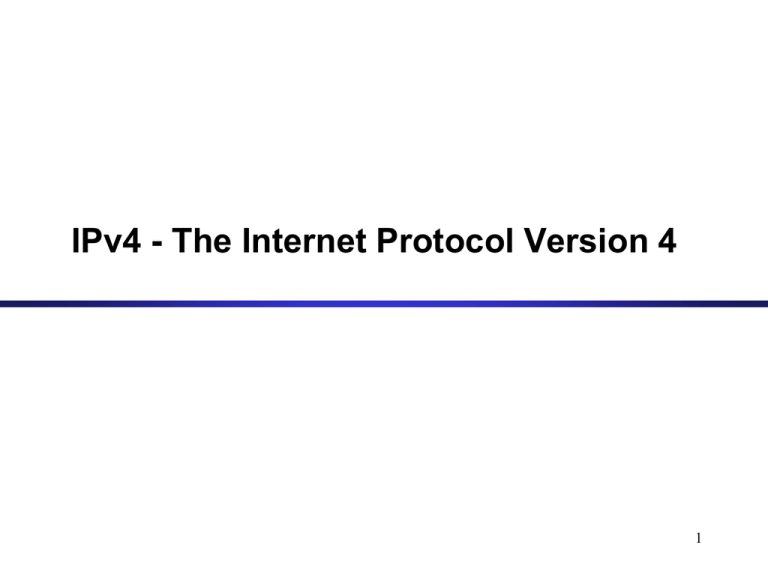
IPv4 - The Internet Protocol Version 4 1 Orientation • IP (Internet Protocol) is a Network Layer Protocol. TCP UDP ICMP IP ARP Network Access IGMP Transport Layer Network Layer Link Layer Media • There are currently two version in use: IPv4 (version 4) and IPv6 (Version 6) • Here we discuss IPv4 2 IP: The waist of the hourglass • IP is the waist of the hourglass of the Internet protocol architecture A p p lica tio n s HTTP FTP SM TP • Multiple higher-layer protocols • Multiple lower-layer protocols • Only one protocol at the network layer. TCP UDP IP D a ta lin k la ye r p ro to cols P h ysical la yer p ro to cols 3 Application protocol • IP is the highest layer protocol which is implemented at both routers and hosts Application Application protocol Application TCP TCP protocol TCP IP Data Link Host IP IP protocol Data Link Data Link IP IP protocol Data Link Router Data Link Data Link IP protocol Data Link Router Data Link IP Network Access Host 4 IP Service • The delivery service of IP is minimal: – Unreliable No attempt is made to recover lost packets – Connectionless Each packet is handled independently – Best effort No guarantees are made on the service • This service is also called a datagram service • Consequences: – Higher layer protocols have to deal with losses – Packets may be delivered out-of-sequence 5 Delivery modes • Supported by IPv4 • one-to-one • one-to-all • one-to-many • Not supported by IPv4: • one-to-any unicast Class A, B, C addresses broadcast Broadcast addresses (e.g.,255.255.255.255, 128.100.255.255) (unicast) (broadcast) (multicast) (anycast) multicast Class D addresses anycast There are no anycast addresses 6 IP Datagram Format bit # 0 7 8 version header length 15 16 ECN DS Identification time-to-live (TTL) 23 24 31 total length (in bytes) 0 D M F F protocol Fragment offset header checksum source IP address destination IP address options (0 to 40 bytes) payload 4 bytes • 20 bytes ≤ Header Size ≤ (24 -1) x 4 bytes = 60 bytes • 20 bytes ≤ Total Length ≤ (216 -1 ) bytes = 65536 bytes 7 Fields of the IP Header • Version: Set to 4 in IPv4 • Header length): length of IP header, in multiples of 4 bytes • Differentiated Services/ECN field – Until 1998, this field was previously called “Type-of-Service (TOS) field” – Differentiated Service Code Point (DSCP) (6 bits): • Identifies a “class” of traffic – Used to indicate priority and service level of traffic – Explicit Congestion Notification (ECN) (2 bits): • New feedback mechanism used by TCP 8 Fields of the IP Header The following fields play a role in IP fragmentation • Identification • Flags (3 bits): – First bit always set to 0 – DF bit (Do not fragment) – MF bit (More fragments) • Fragment offset 9 Fields of the IP Header • Time To Live (TTL) (1 byte): – Specifies longest paths before datagram is dropped – Role of TTL field: Ensure that packet is eventually dropped when a routing loop occurs Used as follows: – Sender sets the value (e.g., 64) – Each router decrements the value by 1 – When the value reaches 0, the datagram is dropped 10 Fields of the IP Header • Protocol (1 byte): • Specifies the higher-layer protocol. • Used for demultiplexing to higher layers. 4 = IP-in-IP encapsulation 17 = UDP 6 = TCP 2 = IGMP 1 = ICMP IP • Header checksum (2 bytes): A simple 16-bit long checksum which is computed for the header of the datagram. 11 Fields of the IP Header • Options: • Security restrictions • Record Route: each router that processes the packet adds its IP address to the header. • Timestamp: each router that processes the packet adds its IP address and time to the header. • (loose) Source Routing: specifies a list of routers that must be traversed. • (strict) Source Routing: specifies a list of the only routers that can be traversed. • Padding: Padding bytes are added to ensure that header ends on a 4-byte boundary 12 Maximum Transmission Unit • Maximum size of IP datagram is 65535, but the data link layer protocol generally imposes a limit that is much smaller • Example: – Ethernet frames have a maximum payload of 1500 bytes IP datagrams encapsulated in Ethernet frame cannot be longer than 1500 bytes • The limit on the maximum IP datagram size, imposed by the data link protocol is called maximum transmission unit (MTU) • MTUs for various data link protocols: Ethernet: 1500 802.3: 1492 Wifi: 2304 (mostly set to: 1500) PPP: negotiated (mostly used: 512) 13 IP Fragmentation • What if the size of an IP datagram exceeds the MTU? IP datagram is fragmented into smaller units. • What if the route contains networks with different MTUs? FDDI R in g H o st A MTUs: FDDI: 4352 E th e rn e t R o u te r H o st B Ethernet: 1500 • Fragmentation: • IP router splits the datagram into several datagram • Fragments are reassembled at receiver 14 Where is Fragmentation done? • Fragmentation can be done at the sender or at intermediate routers • The same datagram can be fragmented several times. • Reassembly of original datagram is only done at destination hosts !! IP d a ta g r a m H Frag m en t 2 H2 Frag m en t 1 H1 R o u te r 15 What’s involved in Fragmentation? • The following fields in the IP header are involved: version header length DS Identification time-to-live (TTL) protocol total length (in bytes) ECN 0 DM F F Fragment offset header checksum Identification Unique identification of a datagram from a host. Incremented whenever a datagram is transmitted When a datagram is fragmented, the identification is the same in all fragments Flags DF bit is set: Datagram cannot be fragmented and must be discarded if MTU is too small MF bit set: This datagram is part of a fragment and an additional fragment follows this one 16 What’s involved in Fragmentation? version header length DS Identification time-to-live (TTL) Fragment offset Total length protocol total length (in bytes) ECN 0 DM F F Fragment offset header checksum Offset of the payload of the current fragment in the original datagram Total length of the current fragment 17 Example of Fragmentation • A datagram with size 2400 bytes must be fragmented according to an MTU limit of 1000 bytes Header length: 20 Total length: 2400 Identification: 0xa428 DF flag: 0 MF flag: 0 Fragment offset: 0 Header length: 20 Total length: 448 Identification: 0xa428 DF flag: 0 MF flag: 0 Fragment offset: 244 IP datagram Header length: 20 Header length: 20 Total length: 996 Total length: 996 Identification: 0xa428 Identification: 0xa428 DF flag: 0 DF flag: 0 MF flag: 1 MF flag: 1 Fragment offset: 122 fragment offset: 0 Fragment 3 MTU: 4000 Fragment 2 Fragment 1 MTU: 1000 Router 18 Determining the length of fragments • To determine the size of the fragments we recall that, since there are only 13 bits available for the fragment offset, the offset is given as a multiple of eight bytes. As a result, the first and second fragment have a size of 996 bytes (and not 1000 bytes). This number is chosen since 976 is the largest number smaller than 1000–20= 980 that is divisible by eight. The payload for the first and second fragments is 976 bytes long, with bytes 0 through 975 of the original IP payload in the first fragment, and bytes 976 through 1951 in the second fragment. The payload of the third fragment has the remaining 428 bytes, from byte 1952 through 2379. With these considerations, we can determine the values of the fragment offset, which are 0, 976 / 8 = 122, and 1952 / 8 = 244, respectively, for the first, second and third fragment. 19 IPv6 Header Format 32 bits version (4 bits) Traffic Class (8 bits) Payload Length (16 bits) Flow Label (20 bits) Next Header (8 bits) Source IP address (128 bits) Destination IP address (128 bits) Hop Limits (8 bits) IPv6 Packet header • IPv6 has a simplified the header structure: – Headers have fixed size – No fragmentation – No header checksum • Most fields play a similar role as in IPv4: IPv6 IPv4 Version Traffic class Version … similar to … DiffServ Payload length Total length Next Header Protocol Hop Limit TTL • Flow label: Can be used by a source to label packets from the same flow 21

